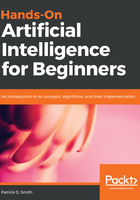
Machine Learning Basics
Artificial Intelligence (AI) is rooted in mathematics and statistics. When creating an Artificial Neural Network (ANN), we're conducting mathematical operations on data represented in linear space; it is, by nature, applied mathematics and statistics. Machine learning algorithms are nothing but function approximations; they try and find a mapping between an input and a correct corresponding output. We use algebraic methods to create algorithms that learn these mappings.
Almost all machine learning can be expressed in a fairly straight-forward formula; bringing together a dataset and model, along with a loss function and optimization technique that are applicable to the dataset and model. This section is intended as a review of the basic mathematical tools and techniques that are essential to understanding what's under the hood in AI.
In this chapter, we'll review linear algebra and probability, and then move on to the construction of basic and fundamental machine learning algorithms and systems, before touching upon optimization techniques that can be used for all of your methods going forward. While we will utilize mathematical notation and expressions in this chapter and the following chapters, we will focus on translating each of these concepts into Python code. In general, Python is easier to read and comprehend than mathematical expressions, and allows readers to get off the ground quicker.
We will be covering the following topics in this chapter:
- Applied math basics
- Probability theory
- Constructing basic machine learning algorithms